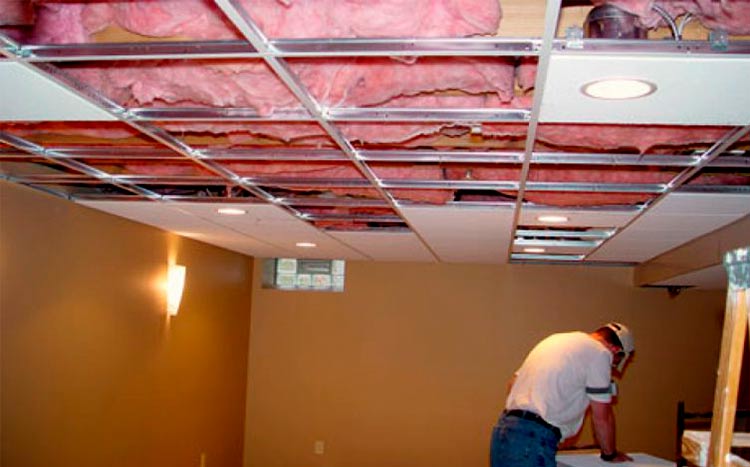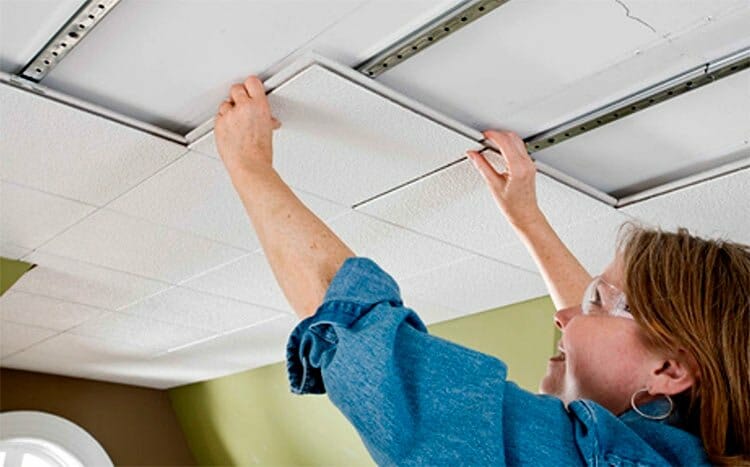Although it may not catch the initial attention of guests, the ceiling in your household holds great significance as a design component. However, as it ages, a suspended ceiling can deteriorate, becoming an unsightly and potentially embarrassing aspect that warrants replacement.
The national average for replacing your drop ceiling with drywall stands at $16 per square foot. Most homeowners spend between $14.50 to $17.50 per square foot.
What we cover
ToggleCost of drop ceiling removal and drywall replacement
The total costs of your ceiling removal and drywall replacement will mainly depend on the size of your room. Expect to spend anywhere from $2 to $7 per sq. ft for the removal of the drop ceiling and around $2.50 – $4.20 per sq. ft for the drywall replacement.
Due to the large amount of work involved in this process, the labor costs also remain high, between $3 – $7.50 per square foot. Contractors charging per hour may cost you around $50 – $100 per hour.
Materials and supplies will also cost you anywhere from $1 – $3 per square foot, depending on your location.
| Service | Low price | Medium price | High price |
|---|---|---|---|
| Remove ceiling - Labor and material (300 sq. ft) | $750 | $1,500 | $2,250 |
| Remove ceiling - Waste and haul-away | $50 | $62.50 | $80 |
| Remove ceiling - Total cost | $800 | $1562.50 | $2,330 |
| Remove ceiling - Total avg. cost per square foot | $2.70 | $5.20 | $7.80 |
| Drywall installation - Labor and material (300 sq. ft) | $750 | $900 | $1,260 |
| Drywall installation - Waste and haul-away | $50 | $62.50 | $80 |
| Drywall installation - Total cost | $800 | $962.50 | $1,340 |
| Drywall installation - Total avg. cost per square foot | $2.70 | $3.20 | $4.50 |
Cost to replace drop ceiling with drywall for 10 x 12 room
For a 10 X 12 room, the average cost of removing the drop ceiling ranges between $240 – $850. The replacement costs with drywall stand at $300 – $400, bringing the totals to around $540 – $1,250.
These costs could, however, be higher depending on the condition of the ceiling and the type of drywall to be used. You might also incur an extra $60 per sq. ft when raising the ceiling.

Cost to remove drop ceiling
The average cost to remove drop ceilings is around $5 per square foot. Depending on your contractor, you can spend around $2.50 per sq. ft on the lower end and about $7.50 per sq. ft on the high end.
Your contractor may also charge you anywhere from $50 – $80 for the waste disposal costs of the old drop ceiling.
Labor cost to replace ceiling tiles
There’s a lot of activities that go into replacing ceiling tiles; from the removal to the waste disposal, to the installation of the new drywall. As such, the labor costs for this job are significantly high.
The average labor costs start from $3 to as high as $8 per square foot or between $50 – $100 per hour.
Other extra services such as prep works will increase your overall costs. If the old ceiling was affected by molds, you might also have to spend on mold remediation first.
Reasons for replacing a drop ceiling
When doing your home renovations, drop ceilings have often been used as a solution to hide the ‘ugly’ ductwork and imperfections on the actual ceiling. But while it does a great job for this, drop ceilings are not all roses.
Many experts recommend replacing this ceiling due to its numerous disadvantages in residential properties, which include;
Drop ceilings deteriorate faster
Compared to other types of ceilings, drop ceilings have a faster deterioration rate. They are not very durable, and in a few years, the ceiling starts sagging, which affects its appearance.
Additionally, if there’s a leak on the roof, the ceiling usually develops some brown stains which can be impossible to remove.
Reduces the room space
One of the most conspicuous cons of using drop ceilings is that it reduces the height of a room. With the tiles hanging above the traditional ceiling, a room ends up looking a few inches shorter. This makes it look a bit stuffier and more disorganized.
Weak and unreliable installation
Unlike the other ceiling types, drop ceilings aren’t built to withstand any physical and natural shocks e.g., earthquakes, a fire. Their thin fabric material puts to question the ceiling’s fragility and durability.

Drop ceiling vs. drywall ceiling
Drop ceilings and drywall ceilings are the two most common options for homeowners in the country. And even though drop ceilings have predominantly been used in offices and other institutions, they can still be perfect for homes.
Drywall ceilings are also quite popular due to their pleasing appearance and smooth finishes – making this decision really hard. You, therefore, have to carefully weigh in the pros and cons of each ceiling type before making your decision.
Some of the key factors you should consider include:
- Easy installation and accessibility
Installing your drop ceiling can be easily completed as a DIY without any help from professionals. It takes a shorter time and once completed, you’ll be able to access all your plumbing, wiring, and vent systems with ease.
Drywall ceilings installations, on the other hand, are harder to install since the panels are heavy and may require two or more people to help. They may also require extra maintenance services such as sanding, priming, and painting.
- Aesthetics
According to most homeowners, drywall ceilings are still the most beautiful models in the market. The drop ceilings have garnered a bad reputation in the market mainly because most people don’t know they have a wide range of tile options.
- Maintenance
The maintenance demands for both drywall and drop ceiling are all relatively easy. Drop ceilings are among the easiest to maintain and replace, thanks to their easy accessibility. However, they can be easily damaged when exposed to water and mold.
Drywall ceilings are also very simple to maintain, requiring only small repairs or repainting.
- Sound Insulation
Installing drop ceilings is one of the best ways to reduce the noise coming from a room. Most drop ceiling tiles are manufactured with a high acoustic rating (better than drywall ceilings) to reduce sound transfer between rooms.
Unless you’ve invested in the expensive soundproof drywall panels for the ceiling, the regular drywall won’t be able to contain the noise.
DIY vs. Professional cost
Since the tasks involved in replacing drop ceilings with drywall are quite simple, most homeowners opt to DIY this process.
Generally, DIYing these services helps you cut down your overall costs and also gives you an opportunity to learn and enjoy a new skill. This, however, doesn’t mean that you shouldn’t hire a professional for this job.
Professional drywallers will not only provide you with high-quality finishes, but they’ll also save you time and give you tips on how to maintain your drywall. This option is, however, more expensive than DIY.
Do it yourself cost
Even though you might save up to 80% ($2 – $5 per sq. ft) savings on your labor costs by replacing the drop ceiling with drywall, you’ll still have some expenses for materials and supplies.
The average cost of these supplies ranges between $1 – $3 per square foot. So, for a 12 X 10 room, the costs would be around $120 – $360.
If this is your first time DIY, your expenses may be higher since you’ll have to purchase equipment and all supplies
Professional cost
If you choose to hire professionals for the job, be ready to dig deeper into your pockets. Most contractors will charge you anywhere from $2 to $7.50 per square foot for the installation process.
For those charging by the hour, these rates stand between $50 to $100 an hour. Pros will also charge higher if they have to do the prep work or waste removal.
You should, therefore, be careful before choosing your contractor, and ensure that all your agreements are documented in a contract.
Pros of drop ceiling vs Drywall
Pros: Drop Ceiling
- Easy access after installation
- Easy DIY repairs
- Better sound insulation
- Conceals imperfections, wires, and ductworks well
Cons: Drop ceiling
- Gives the impression of reduced space and height
- It easily deteriorates in quality
- Not strong like other ceiling options
Pros: Drywall ceiling
- Numerous finish options for better aesthetics
- Cheaper installation than a drop ceiling
- Stronger and sturdy structure
Cons: Drywall ceiling
- Dirty, robust, and complex installation
- Risks of screw pops which can be time-consuming to fix
- Repairs e.g., after water damage, are harder and expensive to fix
- Poor accessibility to electrical, plumbing, and AC units
FAQ's
Can you drywall over a ceiling?
Yes! As long as the ceiling is in good condition, installing drywall over it is a faster and cheaper way to remodel your ceiling. Doing this also saves you the costs of hiring professionals or that of disposal and debris removal.
The only times you shouldn’t drywall over a ceiling includes;
- When mold growth is extensive on the old ceiling
- When the old drywall is too damaged
- When you need to update your entire wiring, pipes, or insulation systems
How much height do you lose with a drop ceiling?
Between 3-8 inches from the lowest joint element. In most states, the building codes stipulate that the suspended ceiling should be at least 3 inches below any plumbing feature and about 5 inches below any lighting fixture.
Is it cheaper to drywall or drop ceiling?
It depends on whether you’ll choose to DIY or hire professionals. In most cases, it’s always cheaper to drywall compared to drop ceiling. This is because most homes today don’t need extra framings to accommodate the drywall.
But if you choose to DIY the drop ceiling installation process, you could save hundreds in labor costs.
Hiring professionals to handle your drywalling project increases the labor costs and thus makes the costs almost as high as that of drop ceiling.
Does drop ceiling reduce noise?
Yes! Drop ceilings provide excellent soundproofing capabilities in two ways i.e., by blocking the sound waves from traveling to the adjacent rooms and, by preventing sound from bouncing around the room.
Most dry ceilings work in one of these ways, although some possess both capabilities. To understand the Noise reduction levels of your drop ceiling, check their Noise Reduction Coefficient (NRC) and Ceiling Attenuation Class (CAC) ratings.













